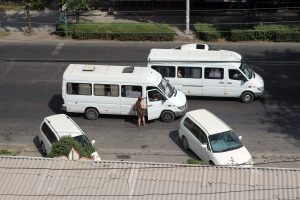Bishkek, a city of just over a million people, should ostensibly not be difficult to get around. Its center is a neat grid; its offshoots can be navigated with a hop, skip, and jump across major thoroughfares.
But the city does have transportation problems, evidenced by descriptions in local media this year of a “transportation collapse.”
Media and local officials seem to equate the transportation collapse with egregious traffic jams (a trip that once took 10 minutes now takes 2 hours, according to a former deputy akim in Bishkek’s Birinchi May District). Traffic jams aren’t only inconvenient, but also have an ecological impact.
In recent years, Bishkek has repeatedly ranked number one worldwide for air pollutants. The proliferation of personal vehicles is one of the leading causes of intense smog that grips the city each winter, according to researchers at the American University of Central Asia.
At a briefing on public transport back in September 2023, Nurlan Sharsheyev, a representative of the Ministry of Natural Resources, Ecology, and Technical Supervision, said, “It has been proven that a car emits the most pollutants at idle speed. That is, when we stand in traffic jams, cars emit more.”
An independent study in September 2020 by pedestrian rights initiative Peshcom observed that personal cars made up 81 percent of vehicles passing through one central intersection during rush hour. Bishkek is not unique in having personal cars, often carrying just the driver, clog up streets. Local officials have pointed to the importance of riding public transport to reduce congestion and improve the traffic situation. Saying that people should ride public transportation is not enough though, however; there need to be serviceable alternatives to taking a taxi or driving a personal car to get around Bishkek.
Historically, there has been a robust system of semi-public transportation. Bishkek has relied on minibuses, Sprinter vans called marshrutkas in Russian for the word “route,” to carry people around the city and to outlying suburbs and villages. In the study by Peshcom, they estimated some 46 percent of riders during rush hour were traveling on 174 minibuses that crisscross the city.
But marshrutkas appear to be on the way out in Bishkek.
In September 2023, local media outlet Kaktus reported that “if just a few years ago there were 4.5 thousand minibus taxis running around Bishkek, this year there are just over a thousand of them left.” This could stem from the financial difficulties of operating the marshrutka lines. On top of gas, insurance, and the cost of renting a vehicle, marshrutka drivers pay fees to companies that own the route. The minibus fare is centrally set, though, and despite several fare hikes in recent years, drivers on low-profit routes claimed to earn just 200-500 Kyrgyz soms per day (about $3-6 dollars). Drivers are fed up, and transportation companies have also announced they would cut lines due to financial losses.
Bishkek’s mayor’s office is speeding up the process of marshrutka providers closing up shop. In April 2024, the city announced it would be closing minibus routes in the city center in a three-phase process that would culminate on June 1.
The policy was meant to improve the comfort and quality of public transportation in the city by introducing express bus routes and offering an opportunity for cashless payment, among other benefits that would be difficult to implement on privately-operated minibuses.
Prior to the phase out of minibuses in downtown Bishkek, officials have been bumping up bus infrastructure. Kyrgyzstan has imported vehicles from China and is pursuing grants from the Asian Development Bank to purchase battery-powered buses. Between August and December 2023, the total number of buses in Bishkek went from 130 to 800 units.
Overlooking the fact that at least 1,200 buses are needed to properly serve the city, the buses have not exactly been a hit in Bishkek. In an Instagram video, media outlet Kloop showed a clip of a city bus’s internal temperature at 45 degrees Celsius (113 degrees Fahrenheit). The video explained that it’s not possible to cool the bus down, though, because the city purchased models that don’t have working air conditioners. According to Bishkek’s Director of Transportation Ulanbek Beishenbayev, buses with air conditioning would have been too expensive.
It’s not even July yet; there are months of scorching heat left in Bishkek.
Despite the various schemes to reduce traffic jams and make public transportation more comfortable, the city’s transportation collapse persists.

































